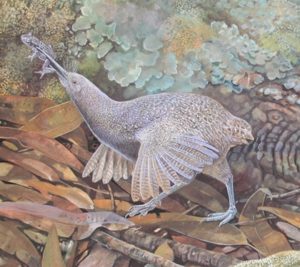
The kiwi, the iconic New Zealand flightless nocturnal bird, is not a dwarf version of a distant ancestor but more likely evolved from a tiny bird that could have flown from Australia, according to a Flinders University palaeontologist.
The findings of a study soon to be published in the Proceedings of the 8th International Meeting of the Society of Avian Paleontology and Evolution reveal the evolutionary pathway of the kiwi, overturning a commonly held theory championed by the late eminent evolutionary biologist Stephen Jay Gould.
Research Fellow Dr Trevor Worthy, who joined Flinders earlier this year from the University of Adelaide, discovered the fossil three years ago at St Bathans in Central Otago.
He said the study results are supported by the genetic evidence that the kiwi is related to the Australian emu and not the New Zealand moa, an enormous emu-like bird that became extinct some 700 years ago.
“One of the distinguishing attributes of the kiwi is that it lays an enormous egg, which is about a quarter of the bird’s body weight and occupies most of the bird,” Dr Worthy, an internationally-recognised expert on the moa, said.
“Gould’s 1986 essay, which sought to explain the origins of the kiwi egg’s size, promoted the idea that the kiwi was highly derived from a large moa-like ancestor, and had shrunk in size while retaining the egg size of this ancestor,” he said.
“This fossil from the early Miocene, about 20 million years ago, shows us that it’s a tiny bird about one third of the size of a small kiwi today. It suggests the opposite is, in fact, the case – that the kiwi has developed towards a larger size, a trend that is seen in many birds from the early Miocene.
“And if, as the DNA suggests, the kiwi is related to the emu, then both shared a common ancestor that could fly. It means they were little and volant and that they flew to New Zealand.”
Dr Worthy said it was not uncommon for birds to “jump” from Australia to New Zealand, citing the Mallard duck, the little banded dotterel and the cattle egret as three species which regularly fly back and forth.
“We need to find wing bones to put the theory beyond all doubt,” he said.
Dr Worthy’s research into the moa also continues. A paper published in September in the Proceedings of the National Academy of Sciences presented the results of research he conducted with colleagues at the University of Adelaide using the ancient DNA found in moa droppings to determine the animal’s diet.
“We found after using ancient DNA to identify the depositor that there were actually four species of moa dropping coprolites in the same rock shelter over 1500 years. We used three methods to analyse the diet of each species: DNA analysis to identify the plants they ate; a more traditional method which looked at the cuticles and seeds and wooden structures of the plants to identify them; and looking at the pollen grains ingested with the food,” he said.
“The most amazing aspect of the study was that only 20 per cent of the plants eaten were found by all of the methods. If you took just one, you missed out on about 60 or 70 per cent of the species the bird was actually eating.
“That multi-discipline method of analysis has given quite a rich insight into the biology of these birds. Importantly, the research shows that moa have not been replaced in the forests by the introduction of introduced ungulates such as deer and goats.”

